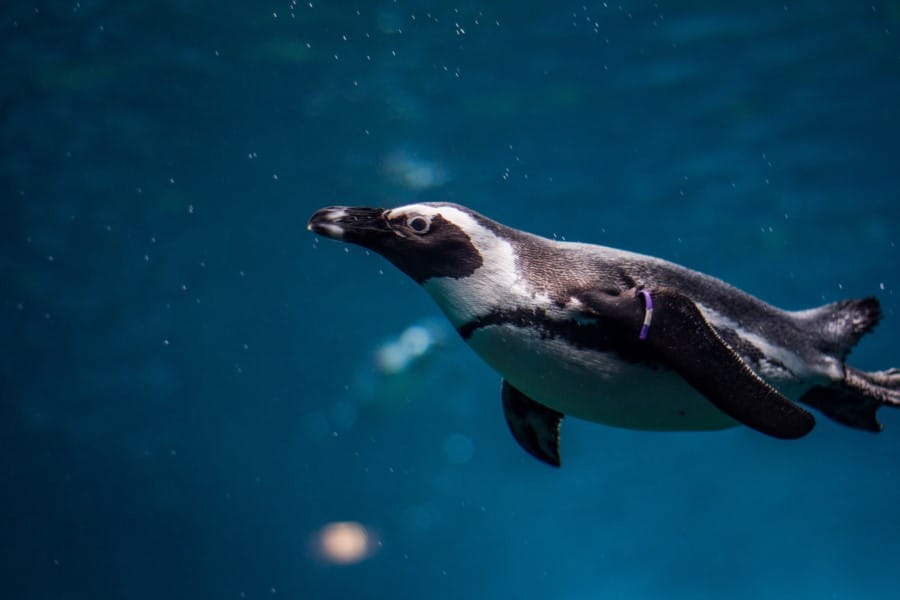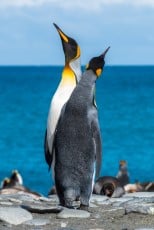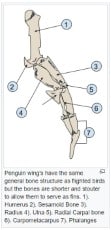Can penguins fly? Sounds like you’ve also often wondered what penguins have wings for? Perhaps they can fly? So in this article, we’re going to provide the penguin flying facts on whether they can fly, and what their wings are used for.
Can Penguins Fly? Penguins are flightless. Although they have wings, they don’t use them to get airborne and therefore, they don’t fly in the traditional sense we would usually associate with other birds. Being partially aquatic they spend half their lives in water and the other half on land but never in the air.
Out of the total of 17 species (some say 20) of penguins. None of them can fly. Most of the species are found in the Antarctic region and the multitude of islands that surround the Antarctic. But were they able to fly at any point? Let’s explore further.
You might also want to check out what penguins eat. And also Are Penguins Birds.
Did Penguins ever fly?
The modern penguins we know today have never flown. However, it is likely that eons ago they began to evolve from flying birds. They have similarities to other pelagic birds such as auks, razorbills, and puffins, as well as loons, petrels, and albatrosses.
Scientists have struggled to pinpoint the exact ancestors of the penguins. And it’s possible that today’s penguins are a product of convergent evolution. This is a process in which completely different species evolve in similar ways, potentially as a cause of the similar environments that the creatures live in.
Why did Penguins stop flying?
Scientists haven’t found a definite theory as to why penguins stopped flying, and there are many different possibilities as to why the change occurred.
Penguins mainly feed on foods such as fish, squid, crustaceans, and krill – all underwater marine species that the birds would have had to spend large amounts of time diving for. The better adapted they were to dive, then the more chance they had of being successful in catching their prey, the more successful in catching their prey then the higher their chances of survival.
As a result of this evolution adapted the penguins for efficient diving skills and as a result, their wing shapes changed to allow for this. Eventually, penguins’ wings became shorter, and rounder until they became unsuitable for flight.

A study carried out by PNAS suggests that actually, it was too “energy expensive” for penguins to get off the ground and fly when actually they were more than sufficient in foraging for their food or escaping danger by diving into the water.
As well as the change in their wing shapes the bones of the penguins became thicker, a notable difference from flying birds that have very light or even hollow bones to make flying easier.
Their bodies also began to get larger – another adaptation to help them dive. Today the world’s largest penguin – the emperor Penguin, is one of the most proficient divers; staying submerged for up to 20 minutes at a time, and reaching depths of 15 feet. But a big body isn’t easy to get off the ground!
So, essentially the penguin traded its ability to fly in order to dive for its food instead. Here’s a bit more detail about the Emperor Penguin.
Emperor Penguin

The emperor penguin is actually the tallest and also the heaviest of all living species of Penguin and is endemic to Antarctica.
The male and female both have similar plumage and are both a similar size, reaching up to 122 cm in height and weighing anything from 22 to 45 kg.
When did Penguins stop flying?
There is no conclusive evidence as to the exact point at which penguins stopped using their wings for flight. So it’s hard for scientists to determine exactly when the penguin stopped flying. Although some believe it was around the time of the Cretaceous period.
However, a giant penguin fossil was discovered in the Waipara Riverbed in New Zealand.
The fossil was 150cm in length and is believed to have been 61 million years old. So although no one can be sure of the exact time period I guess it’s fair to say that penguins haven’t flown for a very, very long time.
What are Penguin’s wings used for?
So why do Penguins have wings? The penguin’s wing is used to fly – in a different manner. Not through the air but through the water. With their tapered and flattened design, the penguin’s wing is used in an up and down motion, similar to flying in order to propel them through the water.
Their wings allow them to dive deep underwater as well as pursue prey at speed. The gentoo penguin is the fastest of the species and can swim at up to 22mph. But can a penguin outrun a seal?
As well as slicing through the water their wings are powerful enough to be able to propel from under the surface back onto land, where they will use their wings to help balance their larger bodies as they waddle about.
Can penguins fly – Penguin wing anatomy

Unlike other birds, the penguin’s wing is hard, rigid, and completely fixed from the elbow to the wrist.
Not only does this allow for extra strength and power it also minimizes the risk of injury to the wing. The wings are used for propulsion only and penguins rely on their feet for any breaking or steering.
image source: wikipedia
So, whilst the penguin might not be able to fly through the air, they certainly know how to move in a marine environment.
Can penguins fly – Education Resources
For all those Penguin enthusiasts, continue your learning about Penguins. Find out much more about them in this complete guide to Penguins.
Penguins of the World
Can penguins fly – Video Resources
To finish…
Now you know why Penguins can’t fly, why they did and when it stopped, as well as how useful their wings actually still are! So now you can impress all your friends with your knowledge of Penguins!
This content has been checked and verified by a qualified veterinary practitioner. The article has been reviewed by our editorial board and has been approved for publication in accordance with our editorial policy.
